In luxury indulgences, few items carry the same mystique and allure as a Cuban cigar. Revered for their exquisite craftsmanship, rich flavors, and storied history, Cuban cigars symbolize sophistication and prestige. In this blog, we embark on a journey to demystify the world of Cuban cigars, delving into their origins, production processes, and the diverse range of types that captivate aficionados worldwide.
Origins and Legacy :
The story of Cuban cigars traces back centuries, intertwining with the vibrant tapestry of Cuban culture and heritage. Tobacco has long been ingrained in the fabric of Cuban society, with indigenous peoples cultivating and using the plant for ceremonial and medicinal purposes. However, it was the arrival of Spanish colonizers in the 16th century that laid the foundation for Cuba's tobacco industry.
Over the centuries, Cuba's ideal climate and fertile soil gave rise to some of the world's finest tobacco, setting the stage for the emergence of iconic cigar brands such as Montecristo. These brands, steeped in tradition and craftsmanship, have become synonymous with excellence in the world of cigars, earning Cuba its reputation as the cigar capital of the world.
The Art of Cuban Cigar Making :
Crafting a Cuban cigar is an intricate and labor-intensive process that demands skill, patience, and a deep understanding of tobacco. From selecting the finest leaves to meticulous rolling and aging, every step in the production process is meticulously executed to ensure the highest quality end product.
Central to the art of Cuban cigar making is the blending of tobacco leaves, a process overseen by master blenders who possess an intimate knowledge of each leaf's unique characteristics. By skillfully combining different types of tobacco, blenders create cigars with a wide range of flavor profiles, from the smooth and creamy to the bold and robust.
Exploring the Different Types :
One of the most captivating aspects of Cuban cigars is the diversity of types and blends available, each offering a distinct smoking experience for enthusiasts to savor. Here are some of the most notable types:
Cohiba: Renowned for its luxurious taste and impeccable craftsmanship, Cohiba cigars are often characterized by creamy flavors with hints of cocoa, leather, and cedar.
Montecristo: A classic among cigar aficionados, Montecristo cigars are known for their medium to full-bodied flavors, often featuring notes of spice, wood, and earthiness.
Partagás: Bold and robust, Partagás cigars are favored by those who appreciate intensity and complexity. Expect deep, earthy flavors with hints of pepper, wood, and espresso.
Romeo y Julieta: With their refined and elegant character, Romeo y Julieta cigars offer a smooth smoking experience with notes of nuts, coffee, and sweet spices.
Hoyo de Monterrey: Balanced and nuanced, Hoyo de Monterrey cigars are prized for their medium-bodied flavors, often with hints of cedar, nuts, and subtle sweetness.
Punch: Known for their full-bodied flavors and bold character, Punch cigars are perfect for those who crave intensity. Look for notes of leather, spices, and dark chocolate.
Conclusion :
In conclusion, Cuban cigars represent the epitome of luxury and craftsmanship, offering enthusiasts a journey of indulgence and discovery. From their rich history and tradition to the diverse array of types and blends available, Cuban cigars continue to captivate and inspire aficionados around the world. Whether you're a seasoned smoker or a curious newcomer, exploring the world of Cuban cigars is an experience filled with passion, elegance, and the timeless allure of the finest tobacco.






